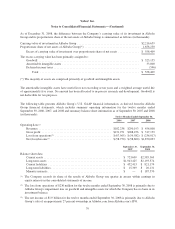Yahoo 2008 Annual Report Download - page 93
Download and view the complete annual report
Please find page 93 of the 2008 Yahoo annual report below. You can navigate through the pages in the report by either clicking on the pages listed below, or by using the keyword search tool below to find specific information within the annual report.
Yahoo! Inc.
Notes to Consolidated Financial Statements—(Continued)
December 31, 2008
Less than 12 Months 12 Months or Greater Total
Fair
Value
Unrealized
Loss
Fair
Value
Unrealized
Loss
Fair
Value
Unrealized
Loss
U.S. Government and agency securities ..... $ — $ — $ — $— $ — $ —
Corporate debt securities ................. 72,585 (2,521) 18,640 (464) 91,225 (2,985)
Corporate equity securities ............... — — — — — —
Total investments in available-for-sale
securities ....................... $72,585 $(2,521) $18,640 $(464) $91,225 $(2,985)
The Company’s investment portfolio consists of liquid government, agency, municipal, and high-quality fixed-
income corporate securities. Investments in both fixed rate and floating rate interest earning instruments carry a
degree of interest rate risk. Fixed rate securities may have their fair market value adversely impacted due to a rise
in interest rates, while floating rate securities may produce less income than expected if interest rates fall. Fixed
income securities may have their fair market value adversely impacted due to a deterioration of the credit quality
of the issuer. The longer the term of the securities, the more susceptible they are to changes in market rates.
Investments are reviewed periodically to identify possible other-than-temporary impairment. The Company has
the intent and ability to hold these securities for a reasonable period of time sufficient for a forecasted recovery
of fair value up to (or beyond) the initial cost of the investment. The Company expects to realize the full value of
all of these investments upon maturity or sale.
Effective January 1, 2008, the Company adopted SFAS 157 for financial assets and liabilities. SFAS 157
establishes a framework for measuring fair value and expands disclosures about fair value measurements by
establishing a fair value hierarchy that prioritizes the inputs to valuation techniques used to measure fair value.
The hierarchy gives the highest priority to unadjusted quoted prices in active markets for identical assets or
liabilities (Level 1 measurements) and lowest priority to unobservable inputs (Level 3 measurements). The three
levels of the fair value hierarchy under SFAS 157 are described below:
Basis of Fair Value Measurement
Level 1 Observable inputs that reflect quoted prices (unadjusted) for identical assets or liabilities in active
markets.
Level 2 Inputs reflect quoted prices for identical assets or liabilities in markets that are not active; quoted prices
for similar assets or liabilities in active markets; inputs other than quoted prices that are observable for
the asset or the liability; or inputs that are derived principally from or corroborated by observable
market data by correlation or other means.
Level 3 Unobservable inputs reflecting the Company’s own assumptions incorporated in valuation techniques
used to determine fair value. These assumptions are required to be consistent with market participant
assumptions that are reasonably available.
87
























